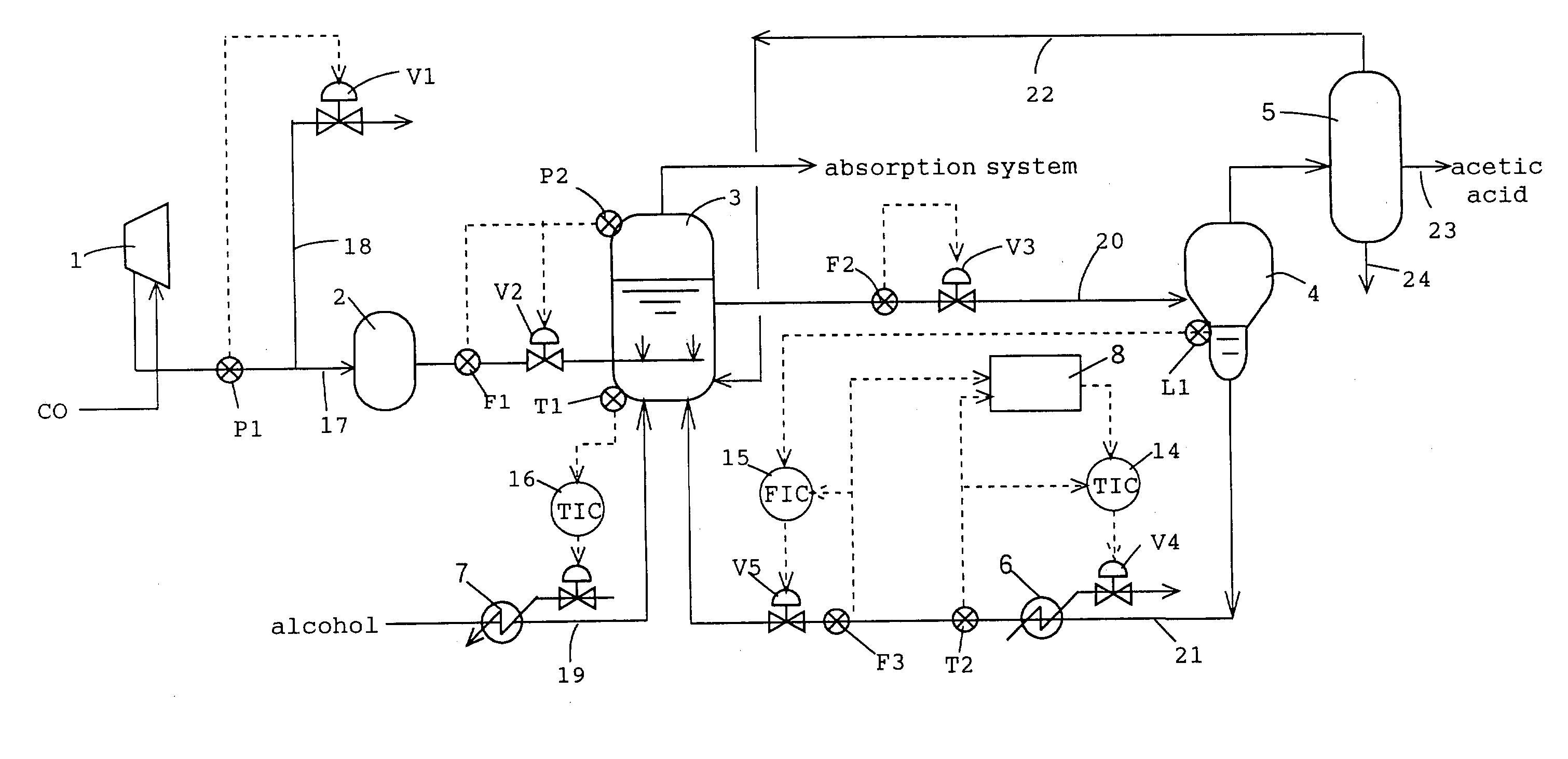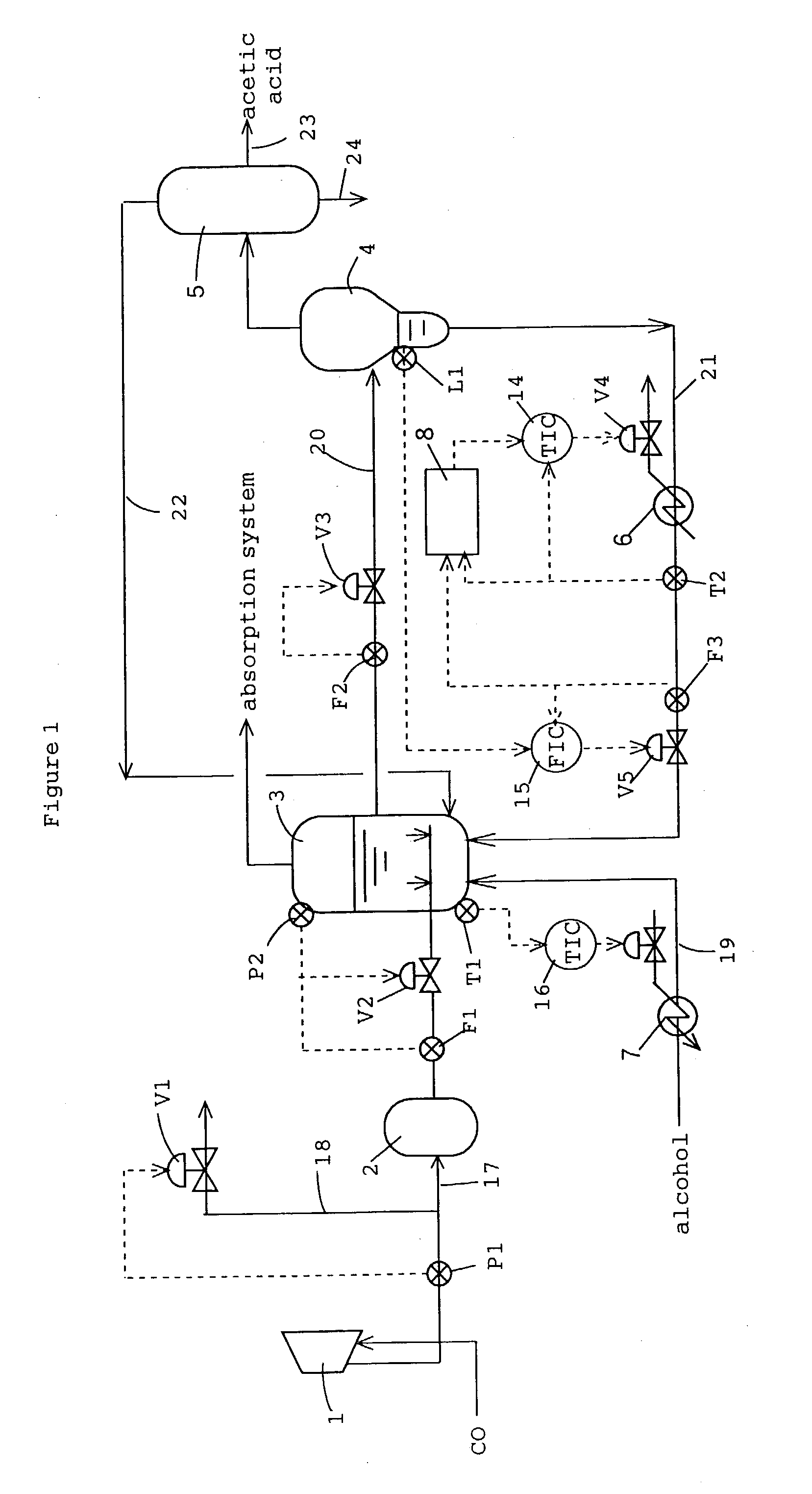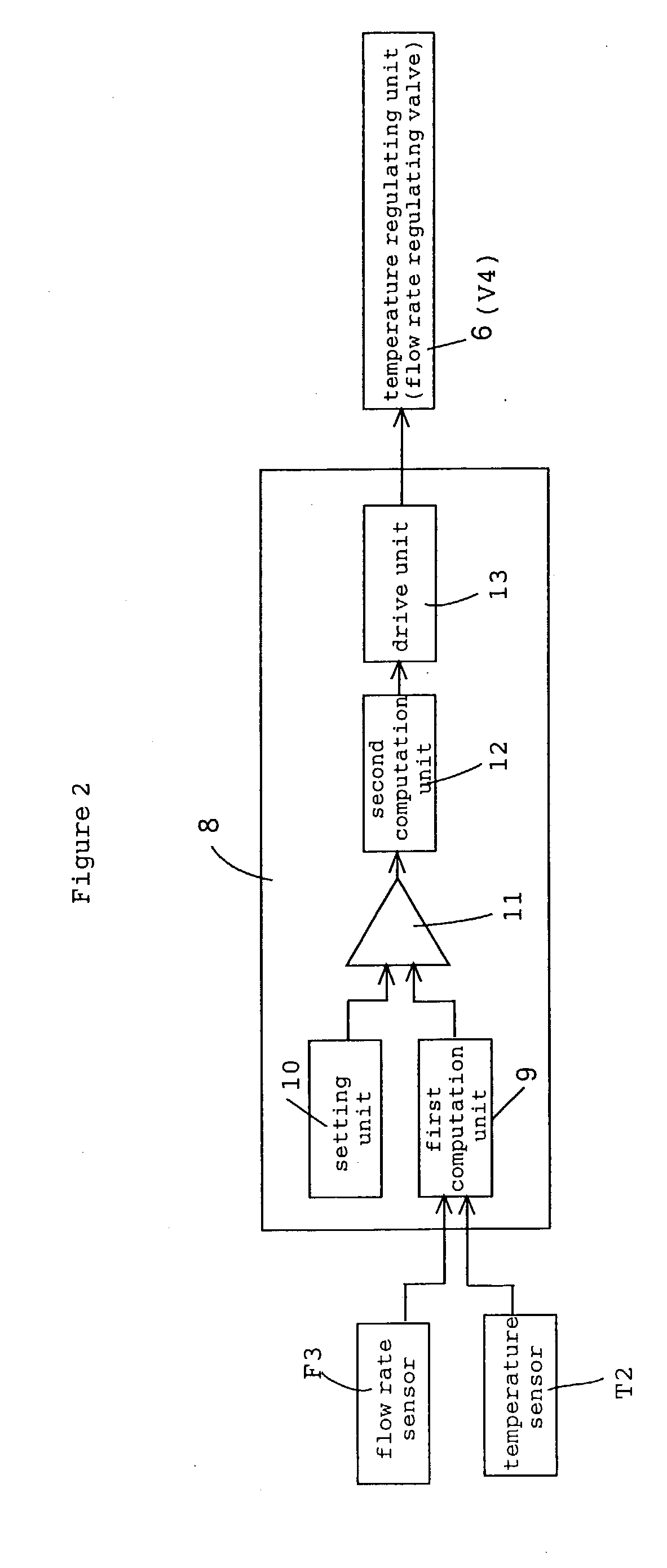[0008] The inventors of the present invention made intensive studies to achieve the above objects, and finally found that (1) even when a separated component (such as a high boiling point component or fraction, etc.), which has been separated by
distillation from a carbonylation reaction mixture, is circulated (or returned) to the reaction system (i.e., the pressurized reaction system) steadily at a predetermined rate, the circulation rate (return flow rate) of the separated component will fluctuate, the temperature of the reaction system will fluctuate accordingly, the pressure of the reaction system will fluctuate in accompaniment with this temperature change even when carbon
monoxide is supplied to the reaction system steadily at a predetermined rate, and the above-mentioned temperature and pressure fluctuations will be large especially in the case where the
reaction temperature of an
exothermic reaction system is controlled by the circulation rate (return flow rate) of the separated component and without using a cooling unit, and that (2) when the temperature of the circulated separated component is controlled according to (or depending on) the heat quantity of the separated component that is returned to the reaction system, the temperature and pressure fluctuations of the reaction system can be suppressed (or restrained) effectively, the
discharge amount of carbon monoxide can be reduced to enable effective use of carbon monoxide for reaction, and the reaction system can be stabilized. The present invention was accomplished based on the above finding.
[0024] A
level sensor L1, for detecting the height of the liquid level of the
liquid phase, is mounted onto the lower part of the flash distillation column 4. Furthermore a temperature sensor T2, for detecting the temperature of the first high boiling point component (liquid component) that is returned to the reaction system, and a flow rate sensor F3, for detecting the flow rate of the first high boiling point component, are mounted onto the circulation line 21. The detection data from this temperature sensor T2 are sent or transmitted to the
control unit 14, and this
control unit controls the temperature of the high boiling point component by means of a heat medium flow rate regulating valve V4 and a
temperature control unit (
heat exchanger) 6, provided at the first circulation line 21. Furthermore, the detection data with respect to the height of the liquid level provided by the above-mentioned
level sensor L1 and the detection data from the above-mentioned flow rate sensor F3 are transmitted or provided to the control unit 15, and based on these detection data, this control unit controls the circulation rate (return flow rate) of the high boiling point component by means of the flow rate regulating valve V5 provided in the first circulation line 21 to thereby maintain the liquid level at the flash distillation column 4 at a predetermined height position.
[0029] With a process equipped with such a control device, even when the circulation rate (return rate) of the high boiling point component in the first circulation line 21 fluctuates, since the heat quantity of the circulated high boiling point component is controlled in accordance with (or in response to) the circulation rate (return rate) of the high boiling point component that occupies a large portion of the flows returned to the reaction system, temperature fluctuations and pressure fluctuations within the reactor 3 can be suppressed significantly and the
acetic acid production process can be stabilized. For example, when acetic acid is industrially produced under the conditions of the above-described acetic
acid production plant, the temperature of the reaction system can be controlled in an extremely stable manner with respect to the reference temperature, that is for example, within a range of reference temperature .+-.0.5.degree. C. (preferably within a range of reference temperature .+-.0.3.degree. C. and especially within a range of reference temperature .+-.0.2.degree. C.). Furthermore, since temperature and pressure fluctuations (variations) can be suppressed or inhibited and the reaction system can be stabilized, not only the carbon monoxide feed rate and
methanol feed rate but the acetic
acid production rate can also be increased. Furthermore, the
discharge rate of carbon monoxide from the exhaust line 18 can be reduced and the carbon monoxide can thus be utilized effectively in the carbonylation reaction.
[0050] The first high boiling point component and / or the second high boiling point component may contain high boiling point byproducts in some cases. Also, the first low boiling point component and / or the second low boiling point component may contain low boiling point byproducts in some cases. Thus the high boiling point byproducts or low boiling point byproducts may be separated if necessary from such high boiling point or low boiling point components, and in cases where components that are effective to the reaction are contained, the component containing effective components may be circulated to the reaction system. Further, as has been disclosed in Japanese
Patent Application Laid-open No. 321847 / 1994 (JP-6-321847A), a high boiling point component may be made to contain water (at an amount for example of about 0.5 to 30 weight % and preferably about 1 to 15 weight %) for preventing
precipitation or
sedimentation (or deposition) and stabilizing the catalytic system.
[0053] Though in the above-described example, the temperature of the reaction system is controlled by controlling the heat quantity of the first high boiling point component, the heat quantity of the second low boiling point component that is circulated to the reaction system may also be controlled to control or regulate the temperature of the reaction system even more precisely. For example, the flow rate and temperature of the second low boiling point component may be detected by means of a flow rate sensor and a temperature sensor in the second circulation line and the temperature of the circulated second low boiling point component (the heat quantity of the second low boiling point component) may be controlled based on the detection data from the flow rate sensor and temperature sensor by the same control unit and
temperature control unit as described above to control the temperature of the above-mentioned reaction system at a predetermined temperature and to restrain pressure fluctuations of the
gas phase of the above-mentioned reaction system.
 Login to View More
Login to View More 


